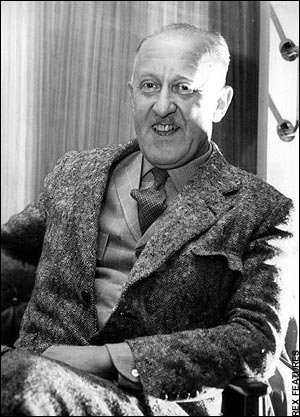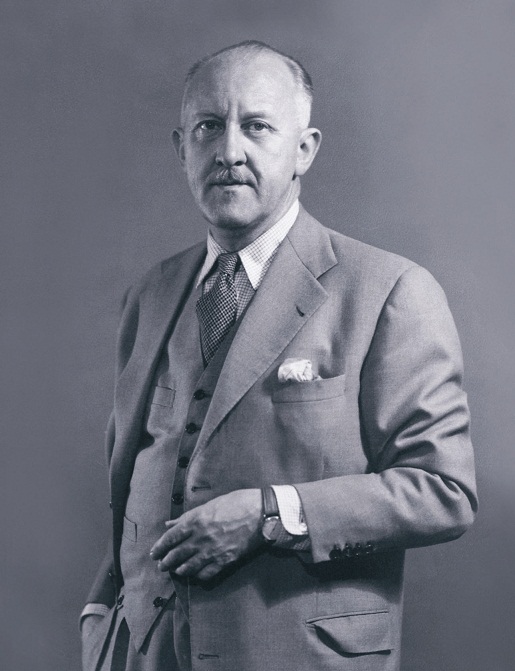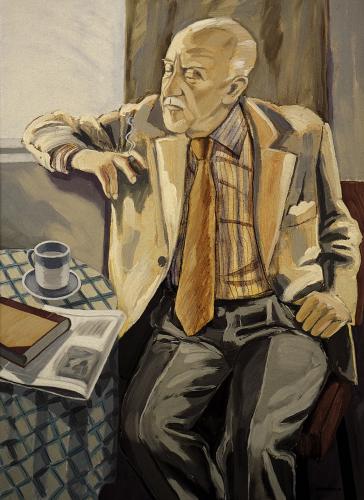<Back to Index>
- Physician Félix Vicq d'Azyr, 1746
- Writer Halldór Kiljan Laxness, 1902
- Admiral in the Dutch Navy Maarten Harpertszoon Tromp, 1598
PAGE SPONSOR



Halldór Kiljan Laxness (born Halldór Guðjónsson) (23 April 1902 – 8 February 1998) was a twentieth century Icelandic writer. Throughout his career Laxness wrote poetry, newspaper articles, plays, travelogues, short stories, and novels. Major influences on his writings include Strindberg, Freud, Sinclair Lewis, Upton Sinclair, Bertolt Brecht and Ernest Hemmingway. He won the Nobel Prize in Literature in 1955.
Laxness was born under the name Halldór Guðjónsson (following the tradition of Icelandic patronymics) in Reykjavik in 1902, the son of Guðjón Helgason and Sigríður Halldórsdóttir. After spending his early years in Reykjavik, he moved with his family in 1905 to Laxnes near Mosfellsbær, a more rural area just north of the capital. He soon started to read books and write stories. At the age of 14 his first article was published in the newspaper Morgunblaðið under the name "H.G." His first book, the novel Barn náttúrunnar (translated Child of Nature), was published in 1919. At the time of its publication he had already begun his travels on the European continent.
In 1922, Laxness joined the Abbaye St. Maurice et St. Maur in Clervaux, Luxembourg. The monks followed the rules of Saint Benedict of Nursia. Laxness was baptized and confirmed in the Catholic Church early in 1923. Following his confirmation, he adopted the surname Laxness (in honor of the homestead where he had been raised) and added the name Kiljan (an Icelandic spelling of the Irish martyr Saint Killian).
Inside the walls of the abbey, he practiced self-study, read books, and studied French, Latin, theology and philosophy. While there, he composed the story Undir Helgahnjúk, published in 1924. Soon after his baptism, he became a member of a group which prayed for reversion of the Nordic countries back to Catholicism. Laxness wrote of his Catholicism in the book Vefarinn mikli frá Kasmír, published in 1927: "For a while he reached a safe haven in a Catholic monastery in Luxembourg, whence he sent home surrealistic poetry and gathered material for the great autobiographical novel recording his mental development, 'a witch brew of ideas presented in a stylistic furioso' (Peter Hallberg), Vefarinn mikli frá Kasmír. I have long thought that this work was marked by the chaos of German expressionism; at any rate it has the abandon advocated by Andre Breton, the master of French surrealism. It created a sensation in Iceland and was hailed by Kristjan Albertsson as the epoch making book it really was. In the future Laxness was always in the vanguard of stylistic development..."
"Laxness's religious period did not last long; during a visit to America he became attracted to socialism.". Partly under the influence of Upton Sinclair, with whom he'd become friends in California, "With Alþydubókin (1929) Laxness . . . joined the socialist bandwagon . . . a book of brilliant burlesque and satirical essays . . . one of a long series in which he discussed his many travel impressions (Russia, western Europe, South America), unburdened himself of socialistic satire and propaganda, and wrote of the literature and the arts, essays of prime importance to an understanding of his own art..." Laxness lived in the United States and attempted to write screenplays for Hollywood films between 1927 and 1929.
By the 1930s he "had beome the apostle of the younger generation" and was attacking "viciously" the Christian spiritualism of Einar Hjörleifsson Kvaran, an influential writer who had also been considered for the Nobel Prize.
"... with "Salka Valka" (1931 - 32) began the great series of sociological novels, often coloured with socialist ideas, continuing almost without a break for nearly twenty years. This was probably the most brilliant period of his career, and it is the one which produced those of his works that have become most famous. But Laxness never attached himself permanently to a particular dogma."
Other major works from this period include Sjálfstætt fólk (Independent People, 1934, 1935), and Heimsljós (World Light, 1937, 1938, 1939, 1940): "... which has been consistently regarded by many critics as his most important work.".
He also traveled to the Soviet Union and wrote approvingly of the Soviet system and culture.
Laxness translated Ernest Hemingway's A Farewell to Arms into Icelandic in 1941, with controversial neologisms.
Laxness published the sprawling three - part Íslandsklukkan (Iceland's Bell, 1943 – 46) a historical novel.
In 1946 Independent People was released as a book of the month club selection in the United States, selling over 450,000 copies.
In response to the establishment of a permanent US military base in Keflavík, he wrote the satire Atómstöðin (The Atom Station), an action which, in part, may have caused his blacklisting in the United States.
In 1953 Laxness was awarded the Soviet sponsored World Peace Council Literary Prize."The demoralization of the occupation period is described . . . nowhere as dramatically as in Halldor Kiljan Laxness' Atómstöðin (1948). . . [where he portrays] postwar society in Reykjavik, completely torn from its moorings by the avalanche of foreign gold"
An adaptation of his novel Salka Valka was filmed by Sven Nykvist in 1954.
In 1955, Laxness was awarded the Nobel Prize in Literature, "for his vivid epic power which has renewed the great narrative art of Iceland":
"His chief literary works belong to the genre . . .[of] narrative prose fiction. In the history of our literature Laxness is mentioned beside Snorri Sturluson and the author of the "Njals saga", and his place in world literature is among writers such as Cervantes, Zola, Tolstoy, and Hamsun. . . He is the most prolific and skillful essayist in Icelandic literature both old and new..."
In the presentation address for the Nobel prize E. Wesen stated:
"He is an excellent painter of Icelandic scenery and settings. Yet this is not what he has conceived of as his chief mission. 'Compassion is the source of the highest poetry. Compassion with Asta Sollilja on earth,' he says in one of his best books. . . . And a social passion underlies everything Halldór Laxness has written. His personal championship of contemporary social and political questions is always very strong, sometimes so strong that it threatens to hamper the artistic side of his work. His safeguard then is the astringent humour which enables him to see even people he dislikes in a redeeming light, and which also permits him to gaze far down into the labyrinths of the human soul."
In his acceptance speech for the Nobel prize he spoke of:
"... the moral principles she [his grandmother] instilled in me: never to harm a living creature; throughout my life, to place the poor, the humble, the meek of this world above all others; never to forget those who were slighted or neglected or who had suffered injustice, because it was they who, above all others, deserved our love and respect... "
Laxness grew increasingly disenchanted with the Soviets after their military action in Hungary in 1956.
In 1957 Halldór and his wife (Auður Sveinsdóttir) went on a world tour, stopping in: New York City, Washington D.C., Chicago, Madison, Salt Lake City, San Francisco, Peking, Bombay, Cairo and Rome.
Major works in this decade were Gerpla (The Happy Warriors, 1952), Brekkukotsannáll (The Fish Can Sing, 1957), and Paradísarheimt (Paradise Reclaimed, 1960). In the sixties Laxness was very active in the Icelandic theatre, writing and producing plays of which The Pigeon Banquet (Dúfnaveislan, 1966) was the most successful. He published the "visionary novel" Kristnihald undir Jökli (Under the Glacier / Christianity at the Glacier) in 1968.
Laxness
continued to write into his eighties while living in his house in
Gljúfrasteinn, an estate located outside of Reykjavík.
His wife, Auður Sveinsdóttir, assumed the duties of personal
secretary and business manager. As he grew older he began to suffer
from Alzheimer's disease and eventually moved into a nursing home where
he died at the age of 95. He was married twice, and had four children.
His house in Gljúfrasteinn is now a museum operated by the Icelandic government.
His daughter
Guðný Halldórsdóttir is an award winning filmmaker. Her first work, a popular magical realism ending film adaptation of Kristnihald undir jōkli (Under the Glacier) screened at world film festivals and repertory cinemas for many years. In 1999 she directed an adaptation of a Laxness story The Honour of the House, which was submitted for Academy Award consideration for best foreign film. His grandson is a hip-hop artist known in Iceland as Dóri DNA. Interest
in Laxness increased in the 21st century in English speaking countries
with the re-publishing of several novels and the publication of Iceland's Bell (2003) and The Great Weaver from Kashmir (2008) in new translations by Philip Roughton.
A biography of Laxness by
Halldór Guðmundsson won the Icelandic literary prize for best work of non-fiction in 2004. In 2005 the Icelandic National Theatre premiered a play by Ólafur Haukur Símonarson, called Halldór í Hollywood (Halldór in Hollywood) about the years that Laxness spent in the United States.